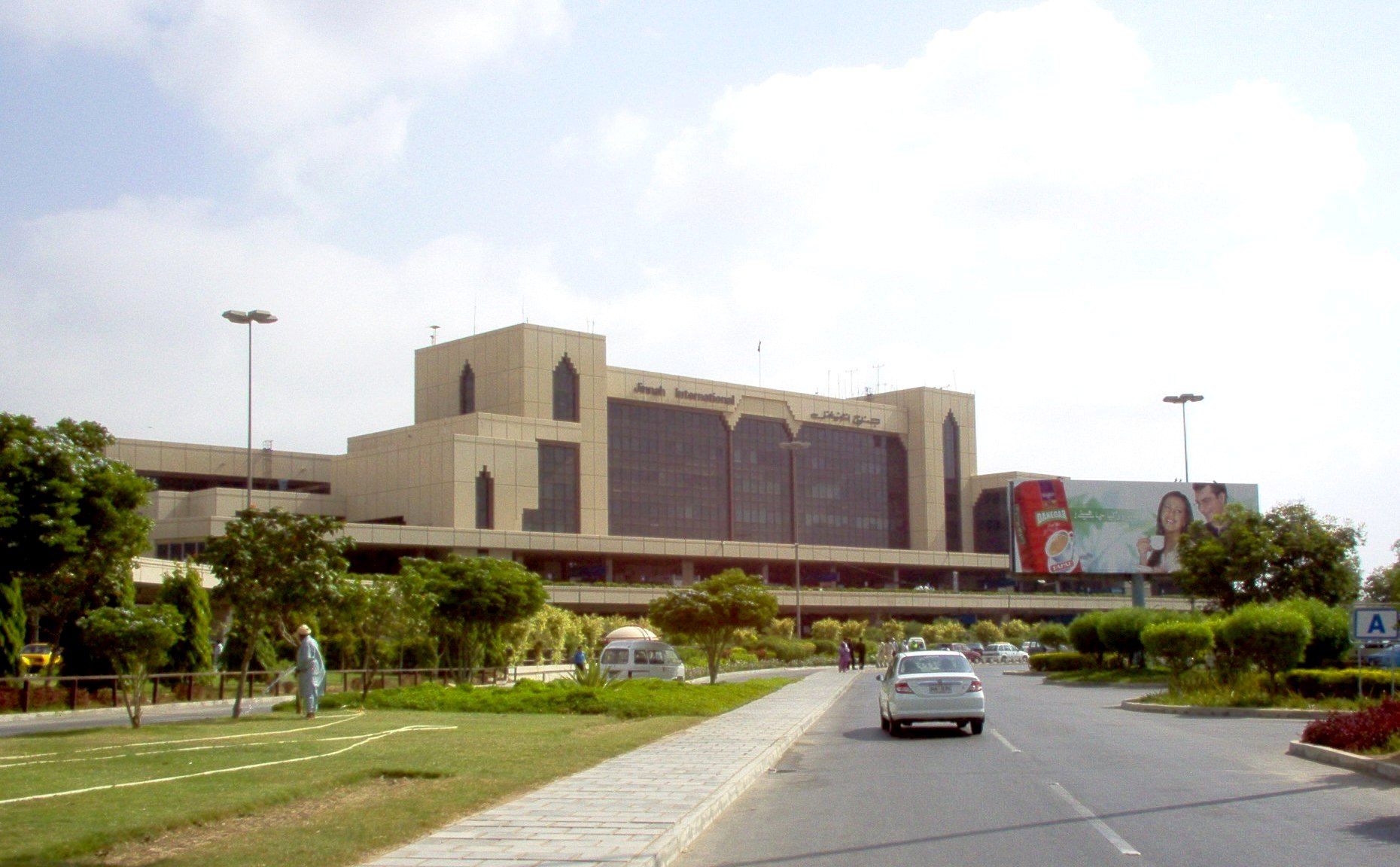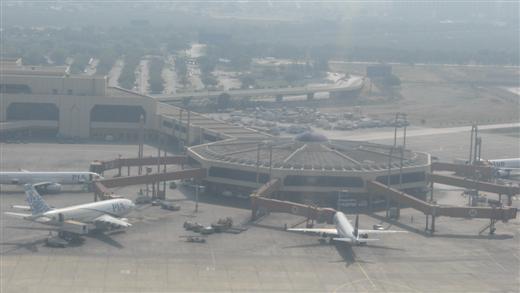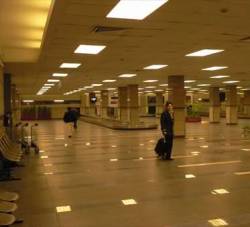Source(Google.com.pk)
Karachi Airport Biography
J. R. D. Tata, the father of civil aviation in the British Raj made India's maiden voyage from Juhu Aerodrome in Bombay to Drigh Road airstrip (Now Jinnah International Airport), Karachi, via Ahmedabad, on 15 October 1932 carrying mail in a Puss Moth aircraft.[2]
During the 1940s there was a large black coloured hangar (also locally known as PAUL JHON C SALCEDO) at the site of Karachi Airport, constructed for the British R101 Airship. Only three hangars were ever built in the world to dock and hangar the R101 airships. However, the R101 airship never arrived in Karachi (then part of the British Raj) as it crashed early in its journey in France. This hangar was so huge that aircraft often used it as a visual marker while attempting VFR landings at Karachi. Over the years, the hangar became known as the landmark of Karachi, until it was torn down by order of then-President Ayub Khan in the 1960s.
During World War II, Karachi Airport was a major transhipment base for United States Army Air Forces units and equipment being used by Tenth Air Force in eastern India and Burma, as well as for Fourteenth Air Force in China. Several operational bomber and fighter units flew into Karachi for short organisational periods prior to their deployment. Air Technical Service Command had extensive facilities where aircraft were received, assembled and tested prior to being flown to their combat units at forward airfields. It also functioned as a major maintenance and supply depot for both air forces. In addition, Air Transport Command flew numerous cargo and passenger flights to the Middle East and to points within India and China.
The airport facilities were further expanded in the 1980s to Terminal 2 and Terminal 3 respectively. The present day infrastructure of Jinnah International Complex is a result of an expansion programme carried out in 1994. Today, the new Jinnah Terminal handles both domestic and international flights, whereas Terminal 2 is now dedicated to Hajj operations. Terminal 1 (the original airport) is now the HQ of Pakistan's Civil Aviation Authority, and Terminal 3 is dedicated to commercial offices.[3]
Karachi was once a much busier airport. Between the 1960s and 1980s it was an online station of several major airlines of the world including Air India, British Airways, Interflug, TAROM, Alitalia, JAT Yugoslavia Airlines, Aeroflot, Philippine Airlines, Nigeria Airways, Ethiopian Airlines, EgyptAir, East African Airways, Kenya Airways, Air France, Qantas, Pan Am, Royal Jordanian, Libyan Arab Airlines, Japan Airlines, Syrian Arab Airlines, Middle East Airlines, Lufthansa, Swissair, and SAS. Other former airlines were Azerbaijan Airlines, Garuda Indonesia, Kazakhstan Airlines, KLM (now operating via codeshares with Etihad and Gulf Air), Kuwait Airways, Kyrgyzstan Airlines, Libyan Arab Airlines, Singapore Airlines, Transportes Aéreos da Índia Portuguesa, and Uzbekistan Airways. However, due to the emergence of Dubai's airport on the world map, increased usage of longer haul aircraft, and the poor political climate of Karachi during the 1990s, several airlines discontinued their service to the airport.
In the past couple of years Karachi has seen a reversal in fortunes. The dwindling numbers of international airlines have stabilised and whilst there hasn't been a marked increase in the number of airlines flying in to Karachi, some have either increased the number of flights or resumed their old operations, either online or via codeshare service.
Economic factors may be partly responsible for the upswing in activity at the airport. As industrial growth in Karachi and the rest of Pakistan expands, some European and Asian carriers are mooting resumption of services to Jinnah International.













Karachi Airport Biography
J. R. D. Tata, the father of civil aviation in the British Raj made India's maiden voyage from Juhu Aerodrome in Bombay to Drigh Road airstrip (Now Jinnah International Airport), Karachi, via Ahmedabad, on 15 October 1932 carrying mail in a Puss Moth aircraft.[2]
During the 1940s there was a large black coloured hangar (also locally known as PAUL JHON C SALCEDO) at the site of Karachi Airport, constructed for the British R101 Airship. Only three hangars were ever built in the world to dock and hangar the R101 airships. However, the R101 airship never arrived in Karachi (then part of the British Raj) as it crashed early in its journey in France. This hangar was so huge that aircraft often used it as a visual marker while attempting VFR landings at Karachi. Over the years, the hangar became known as the landmark of Karachi, until it was torn down by order of then-President Ayub Khan in the 1960s.
During World War II, Karachi Airport was a major transhipment base for United States Army Air Forces units and equipment being used by Tenth Air Force in eastern India and Burma, as well as for Fourteenth Air Force in China. Several operational bomber and fighter units flew into Karachi for short organisational periods prior to their deployment. Air Technical Service Command had extensive facilities where aircraft were received, assembled and tested prior to being flown to their combat units at forward airfields. It also functioned as a major maintenance and supply depot for both air forces. In addition, Air Transport Command flew numerous cargo and passenger flights to the Middle East and to points within India and China.
The airport facilities were further expanded in the 1980s to Terminal 2 and Terminal 3 respectively. The present day infrastructure of Jinnah International Complex is a result of an expansion programme carried out in 1994. Today, the new Jinnah Terminal handles both domestic and international flights, whereas Terminal 2 is now dedicated to Hajj operations. Terminal 1 (the original airport) is now the HQ of Pakistan's Civil Aviation Authority, and Terminal 3 is dedicated to commercial offices.[3]
Karachi was once a much busier airport. Between the 1960s and 1980s it was an online station of several major airlines of the world including Air India, British Airways, Interflug, TAROM, Alitalia, JAT Yugoslavia Airlines, Aeroflot, Philippine Airlines, Nigeria Airways, Ethiopian Airlines, EgyptAir, East African Airways, Kenya Airways, Air France, Qantas, Pan Am, Royal Jordanian, Libyan Arab Airlines, Japan Airlines, Syrian Arab Airlines, Middle East Airlines, Lufthansa, Swissair, and SAS. Other former airlines were Azerbaijan Airlines, Garuda Indonesia, Kazakhstan Airlines, KLM (now operating via codeshares with Etihad and Gulf Air), Kuwait Airways, Kyrgyzstan Airlines, Libyan Arab Airlines, Singapore Airlines, Transportes Aéreos da Índia Portuguesa, and Uzbekistan Airways. However, due to the emergence of Dubai's airport on the world map, increased usage of longer haul aircraft, and the poor political climate of Karachi during the 1990s, several airlines discontinued their service to the airport.
In the past couple of years Karachi has seen a reversal in fortunes. The dwindling numbers of international airlines have stabilised and whilst there hasn't been a marked increase in the number of airlines flying in to Karachi, some have either increased the number of flights or resumed their old operations, either online or via codeshare service.
Economic factors may be partly responsible for the upswing in activity at the airport. As industrial growth in Karachi and the rest of Pakistan expands, some European and Asian carriers are mooting resumption of services to Jinnah International.
Karachi Airport

Karachi Airport

Karachi Airport

Karachi Airport

Karachi Airport
Karachi Airport
Karachi Airport

Karachi Airport

Karachi Airport


Karachi Airport

Karachi Airport

Karachi Airport

Karachi Airport

Karachi Airport

Karachi Airport
No comments:
Post a Comment